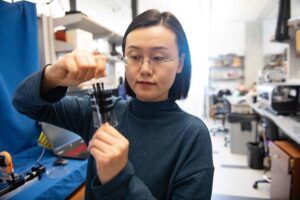AUSTIN, TexasWhen scientists in California reported on an exciting new “left-handed” material two years ago, a vast range of applications was predicted, including “perfect” lenses for DVDs of unrivaled storage capacity.
The report sparked a frenzy of research activity at other universities on both coasts and in Europe and generated tens of millions of dollars in research funding.
Not so fast, says a team of University of Texas at Austin researchers.
Dr. Prashant Valanju, a research scientist with the Fusion Research Center; Dr. Rodger Walser, professor of electrical and computer engineering; and Alaka Valanju, a research associate, shoot down those optimistic predictions in the May 6 issue of the prestigious Physical Review Letters.
“This locomotive has a lot of steam,” Walser said. “A lot has been invested in it, so it’s hard to give it up. But it’s time to get it back on the track.”
There is an upside, he said.
“When materials with new properties are discovered, they always lead to new ideas and products,” Walser said. “That will happen now with these new negative index materials. They can’t be used for the purposes people originally believed, but they’ll find important applications in fields like antennas, sensors and radiation shielding, among others.”
He and his team already are exploring several of those.
The materials under scrutiny are a sub-class of metamaterials: a new science pioneered by Walser to synthesize materials optimized for conflicting applications requirements. The first left-handed material consists of novel arrays of ultra-thin copper wires alternating with flattened copper film loops imprinted on a substrate. They are unique in possessing a negative index of refraction. That is the property that was supposed to produce the miracles.
Index of refraction – positive for normal materials – is a measure of how light is bent when it passes from one substance into another. For example, light hitting a pool of water is deviated from its original course, making underwater objects appear closer than they are.
California scientists and others thought a negative index of refraction would lead to “backward bending” light rays that could be harnessed for use in super-powerful lenses and ultra-high precision opto-electronic devices. Their expectation derived from ideas expressed in a paper published in 1968 by Victor Veselago of the Academy of Sciences, Moscow. Veselago theorized that a negative refractive material – not yet produced in the laboratory – would have that behavior.
Now the material is here. But The University of Texas at Austin team shows that is not the way things work.
“The negative index is there,” Walser said. “But, it won’t do what they’re claiming it will do.”
Walser characterizes the research community’s romance with negative refractive index as a good faith pursuit of an attractive false lead, “but it diverts people and resources from more productive lines of research.”
Virtually all papers published on the subject have dealt with the theoretical side, with only one experimental attempt of making the material in the lab, he said..
“Their error was a simple one, yet nobody saw it,” Valanju said.
The error, he explained, was in making the theoretical assumption of an ideal, single-wavelength (one color) beam of light, endless in both space and time. “That was natural. It’s an approximation we’re taught to make when we study optics,” he said.
In reality, however, light always is a collection of waves – even the intense, piercing red beam of a laser pointer contains many waves with wavelengths only minutely different from red. All signals are transported in the beats (modulations) of carrier waves. In the everyday world of normal materials, carrier and modulations travel together.
“But what happens in negative index materials is that the two travel in totally different directions,” Valanju said. “The carrier refracts negatively, but the signal – which is the information we perceive – always refracts positively, just like in the positive index material.”
He noted, moreover, that the fundamental laws of physics rule out negative signal refraction in any material. “That would require the signal to reach its destination before it leaves its source,” he said. “So, there’s no ‘reverse’ light bending and the things they predict from it can’t happen.”
For further information contact: Becky Rische, (512) 471-7272.



